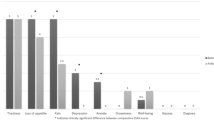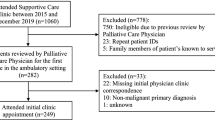Abstract
Purpose
Outpatient palliative care clinics are essential for early symptom management in patients with advanced cancer. Few outpatient programs are available in the Middle East. In this prospective study, we examined the symptom changes among cancer patients seen at a palliative care clinic in Jordan.
Methods
Patients with advanced cancer who had an outpatient palliative care consultation and not delirious were enrolled. The Edmonton Symptom Assessment System (ESAS), Karnofsky Performance Scale (KPS), and Memorial Delirium Assessment Scale (MDAS) were collected at consultation and follow up visit 14–34 days later. We compared symptom changes using paired t test.
Results
Among the 182 enrolled patients, the average age was 53 years, 47 % were females, and 95 % had stage IV cancer. The median duration between the two clinic visits was 21 days (interquartile range 15–28). KPS decreased between visits (mean 68 vs. 66 %, P = 0.004). ESAS pain (5.9 vs. 5.1, P = 0.004) and sleep (4.6 vs. 4.1, P = 0.007) improved significantly over time. The remaining ESAS symptoms decreased in intensity, albeit not statistically significant. Among patients who presented with moderate to severe symptom intensity, pain (7 vs. 6, P < 0.0001), fatigue (7 vs. 6, P = 0.003), nausea (7 vs. 4, P < 0.0001), depression (7 vs. 5, P = 0.0008), anxiety (7 vs. 5, P < 0.0001), drowsiness (6 vs. 5, P < 0.001), appetite (7 vs. 6, P = 0.0007), well-being (7 vs. 6, P < 0.0001), dyspnea (6 vs. 5, P = 0.0006), and sleep (7 vs. 5, P < 0.0001) all improved significantly.
Conclusions
Our outpatient palliative care consultation was associated with improvement in ESAS, particularly for patients who presented with moderate to severe symptoms. Further studies are needed to examine predictors of symptom response, longer term outcomes, and how to improve access to outpatient palliative care in the Middle East.

Similar content being viewed by others
References
Schenck A, Rokoske F, Durham D, Cagle J, Hanson L (2014) Quality measures for hospice and palliative care piloting the PEACE measures. J Palliat Med 17(7):769–775. doi:10.1089/jpm.2013.0652
Walsh D, Donnelly S, Rybicki L (2000) The symptoms of advanced cancer: relationship to age, gender, and performance status in 1,000 patients. Support Care Cancer 8:175–179
Manitta V, Zordan R, Cole-Sinclair M, Nandurkar H, Philip J (2011) The symptom burden of patients with hematological malignancy: a cross-sectional observational study. J Pain Symptom Manag 42:432–442
Seow H, Barbera L, Sutradhar R, et al. Trajectory of performance status and symptom scores for patients with cancer during the last six months of life. J Clin Oncol 29:1151–1158
Hui D, Dos Santos R, Chisholm GB, Bruera E (2015) Symptom expression in the last seven days of life among cancer patients admitted to acute palliative care units. J Pain Symptom Manag 50(4):488–494. doi:10.1016/j.jpainsymman.2014.09.003
Shamieh O, Hui DA (2015) Comprehensive palliative care program at a tertiary cancer Center in Jordan. Am J Hosp Palliat Care 32(2):238–242
Steedman M, Hughes-Hallet T, Knaul F, Knuth A, Shamieh O, Darzi A (2014) Innovation can improve and expand aspects of end-of-life care in low-and middle-income countries. Health Aff 33(9):1612–1619
Hui D, Shamieh O, Paiva C, Perez-Cruz P, Kwon J, Muckaden M, Minjeong P, Yennu S, Kang J, Bruera E (2015) Minimal clinically important differences in the Edmonton symptom assessment scale in cancer patients: a prospective multicenter study. Cancer 121:3027–3035. doi:10.1002/cncr.29437
Kang J, Kwon J, Hui D, Yennurajalingam S, Bruera E (2013) Changes in symptom intensity among cancer patients receiving outpatients palliative care. J Pain Symptom Manag 46:652–660
Moro C, Brunelli C, Miccinesi G, et al. (2006) Edmonton symptom assessment scale: Italian validation in two palliative care settings. Support Care Cancer 14:30–37
Carvajal A, Centeno C, Watson R, Bruera EA (2011) Comprehensive study of psychometric properties of the Edmonton symptom assessment system (ESAS) in Spanish advanced cancer patients. Eur J Cancer 47:1863–1872
Chang VT, Hwang SS, Feuerman M (2000) Validation of the Edmonton symptom assessment scale. Cancer 88:2164–2171
Bruera E, Kuehn N, Miller MJ, Selmser P, Macmillan K (1991) The Edmonton symptom assessment system (ESAS): a simple method for the assessment of palliative care patients. J Palliat Care 7:6–9
Watanabe S, Nekolaichuk C, Beaumont C, Mawani A (2009) The Edmonton symptom assessment system-what do patients think? Support Care Cancer 17:675–683
Breitbart W et al. (1997) The memorial delirium assessment scale. J Pain Symptom Manag 13(3):128–137
Bruera E, Bush SH, Willey J, et al. (2009) Impact of delirium and recall on the level of distress in patients with advanced cancer and their family caregivers. Cancer 115:2004–2012
Schag CC, Heinrich RL, Ganz PA (1984) Karnofsky performance status revisited: reliability, validity, and guidelines. J Clin Oncol 2(3):187–193
Mor V, Laliberte L, Morris J, Weimann M (1984) The Karnofsky performance status scale, an examination of its reliability and validity in a research setting. Cancer 53:2002–2007
Hui D, Elsayem A, Cruz M, Berger A, Zhukovsky D, Palla S, Evans A, Fadul N, Palmer L, Bruera E (2010) Availability and integration of palliative care at US cancer centers. JAMA 303(11):1054–1061
Al-Zahrani O, Eldali A, Zafir Al-Shahri M (2014) Prevalence and severity of pain in cancer patients in an outpatient palliative care setting in Saudi Arabia. Qatar Med J 1:38–45
Strasser F, Sweeney C, Willey J, Benisch-Tolley B, Palmer L, Bruera E (2004) Impact of a half-day multidisciplinary symptom control and palliative care outpatient Clinic in a Comprehensive Cancer Center on recommendations, symptom intensity, and patient satisfaction: a retrospective descriptive study. Pain Symptom Manage 27:481–491
Yennurajalingam SL, Urbauer D, Casper K, Reyes-Gibby C, Chacko R, Poulter V, Bruera E (2011) Impact of a palliative care consultation team on cancer-related symptoms in advanced cancer patients referred to an outpatient supportive care clinic. J Pain Symptom Manag 41:49–56
Yennurajalingam S, Kang J, Hui D, Kang D, Kim S, Bruera E (2012) Clinical response to an outpatient palliative care consultation in patients with advanced cancer and cancer pain. J Pain Symptom Manag 44:340–350
Hearn J, Higginson I (1997) Outcome measures in palliative care for advanced cancer patients: a review. J Public Health 19(2):193–199
Temel J, Greer J, Muzikansky A, Gallagher E, Admane S, Jackson V, Dahlin C, Blinderman C, Jacobsen J, Pirl W, Billings A, Lynch T (2010) Early palliative care for patients with metastatic non-small-cell lung cancer. N Engl J Med 363:733–742
Dalal S, Bruera S, Hui D, Yennu S, Dev R, Williams J, Masoni C, Ihenacho I, Obasi E, Bruera E (2016) Use of palliative care services in a tertiary cancer center. Oncologist 21:1–9
Stromgren A, Groenvold M, Pedersen L, Olsen A, Sjogren P (2002) Symptomatology of cancer patients in palliative care: content validation of self-assessment questionnaires against medical records. Eur J Cancer 38:788–794
Hui D, Kim S, Roquemore J, Dev R, Chisholm G, Bruera E (2014) Impact of timing and setting of palliative care referral on quality of end-of-life care in cancer patients. Cancer 120:1743–1749
Cleeland CS, Mendoza TR, Wang XS, et al. (2000) Assessing symptom distress in cancer patients: the M. D. Anderson symptom inventory. Cancer 89:1634–1646
Basch E, Abernethy AP, Mullins CD, et al. (2012) Recommendations for incorporating patient-reported outcomes into clinical comparative effectiveness research in adult oncology. J Clin Oncol 30:4249–4255
Author information
Authors and Affiliations
Corresponding author
Ethics declarations
Conflict of interest
The authors declare that they have no conflict of interest.
Funding
This research was supported by intermural grant from King Hussein Cancer Center.
Rights and permissions
About this article
Cite this article
Shamieh, O., Khamash, O., Khraisat, M. et al. Impact of outpatient palliative care (PC) on symptom burden in patients with advanced cancer at a tertiary cancer center in Jordan. Support Care Cancer 25, 177–183 (2017). https://doi.org/10.1007/s00520-016-3395-8
Received:
Accepted:
Published:
Issue Date:
DOI: https://doi.org/10.1007/s00520-016-3395-8




